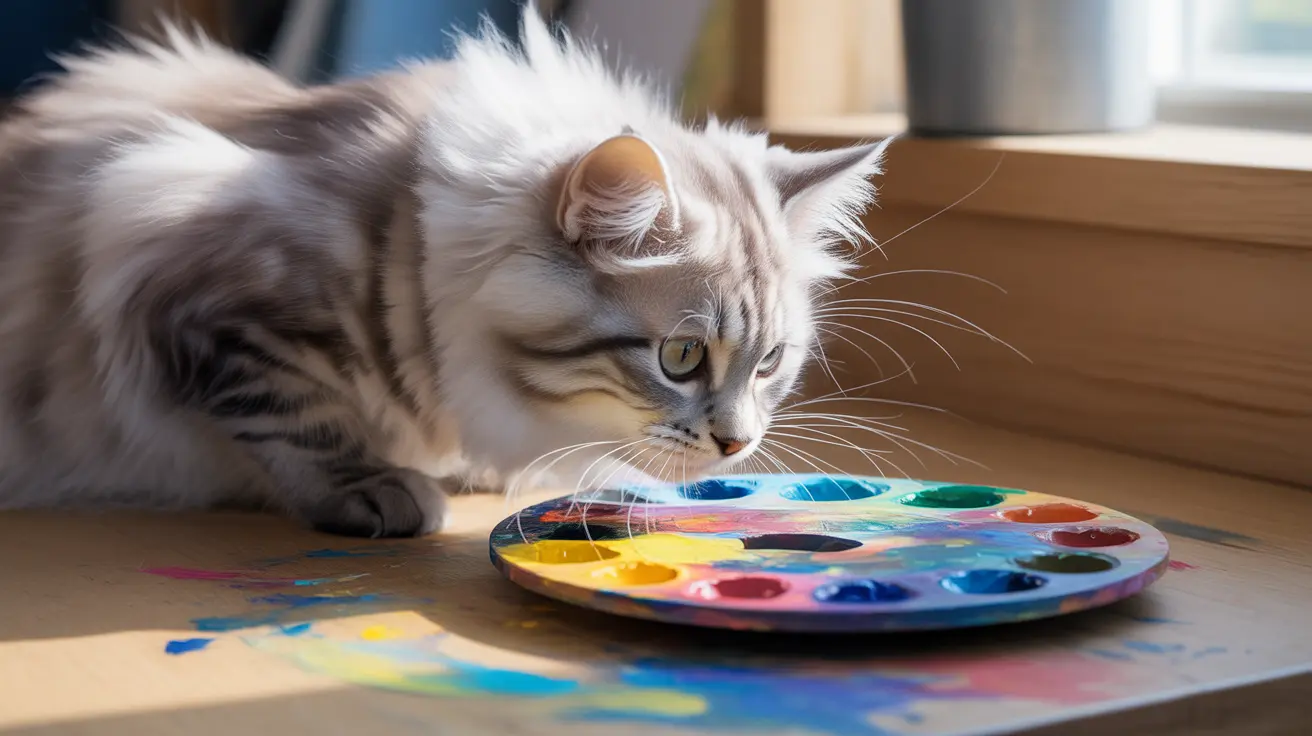When your curious feline encounters paint during home projects or art sessions, it's crucial to understand the potential risks. While acrylic paint is generally considered less toxic than other paint types, it can still pose significant health risks to cats if ingested or exposed to their skin.
As a responsible pet parent, knowing how to identify paint toxicity symptoms and respond appropriately could make a critical difference in your cat's well-being. Let's explore everything you need to know about acrylic paint safety for cats.
Understanding Acrylic Paint Toxicity in Cats
Acrylic paints labeled as "non-toxic" or designed for children typically pose lower risks to cats compared to oil-based or lead-based alternatives. However, even these safer options can cause health issues if ingested in significant quantities.
The main concerns arise from specific paint ingredients, particularly pigments and additives that may contain harmful compounds. Some acrylic paints contain heavy metals like cadmium, chromium, or cobalt, which can be dangerous even in small amounts.
Common Signs of Paint Poisoning in Cats
Immediate Symptoms
Watch for these early warning signs if you suspect your cat has been exposed to paint:
- Excessive drooling
- Pawing at the mouth
- Vomiting or retching
- Lethargy
- Loss of appetite
Severe Symptoms
More serious cases may present with:
- Difficulty breathing
- Seizures or tremors
- Disorientation
- Changes in heart rate
- Severe gastrointestinal distress
Emergency Response and Treatment
If you discover your cat has contacted or ingested paint, take these immediate steps:
- Remove any remaining paint from your cat's reach
- Gently clean paint from fur using lukewarm water and mild soap
- Document the type of paint and approximate amount ingested
- Contact your veterinarian or emergency animal hospital immediately
Do not attempt to induce vomiting unless specifically instructed by a veterinary professional, as this could cause additional harm.
Prevention and Safety Measures
Protect your cat from paint exposure by implementing these safety practices:
- Store all paint supplies in sealed containers in locked cabinets
- Use only pet-safe or non-toxic paints when possible
- Keep cats out of rooms during painting projects
- Clean up spills immediately
- Ensure proper ventilation during painting
- Dispose of paint materials properly
Long-term Health Considerations
While most cats recover well from minor paint exposure with prompt treatment, repeated exposure or ingestion of toxic varieties can lead to chronic health issues. Regular veterinary check-ups are essential if your cat has experienced significant paint exposure, particularly if heavy metals were involved.
Frequently Asked Questions
Is acrylic paint toxic to cats, and how dangerous is it compared to other types of paint?
Acrylic paint is generally less toxic than oil-based or lead-based paints, but it can still be harmful if ingested. The level of toxicity depends on the specific ingredients and amount consumed. While "non-toxic" acrylics are safer, they can still cause gastrointestinal upset and other health issues.
What are the symptoms that my cat has ingested acrylic paint?
Common symptoms include drooling, vomiting, lethargy, loss of appetite, and pawing at the mouth. More severe cases may show neurological symptoms, breathing difficulties, or changes in heart rate.
What should I do immediately if my cat licks or eats acrylic paint?
Contact your veterinarian immediately, clean any paint from fur using lukewarm water and mild soap, and monitor your cat closely. Don't induce vomiting unless directed by a veterinary professional.
Can "non-toxic" acrylic paints still harm my cat if ingested or licked from fur?
Yes, even "non-toxic" acrylic paints can cause illness if consumed in large quantities or if the cat has repeated exposure. They may still contain ingredients that can cause gastrointestinal irritation or other health issues.
How can I prevent my cat from getting exposed to acrylic or other toxic paints during home renovations?
Keep cats in a separate, well-ventilated room during painting projects, store all paint supplies securely, clean up spills immediately, and ensure proper ventilation. Consider using pet-safe paint alternatives when possible.






